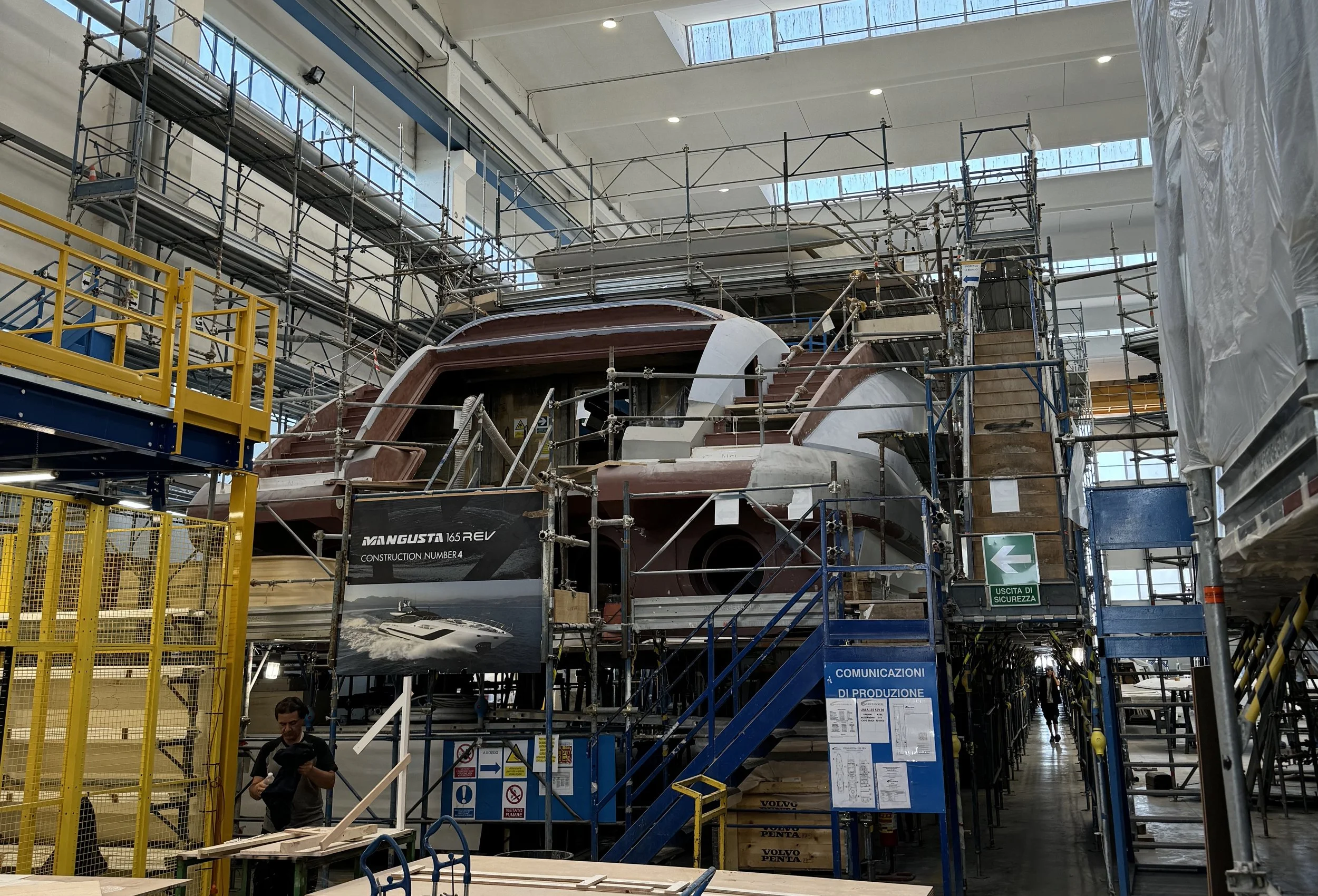How Trade Wars Complicate Build Contracts
A Mangusta 165 REV is built in Viareggio, Italy.
Tariff Turbulence: Who bears the burden of a tariff imposed mid-build?
The recent sparrings of a global trade war have sent a wave of uncertainty through the marine industry—especially among yacht buyers and builders in the middle of long-term build contracts. As tariffs start to find their footing, the quiet complexity of who pays what has the makings of an all-out battle of liability and leverage.
Here’s what every buyer, dealer, and builder needs to know about how today’s tariffs are impacting yesterday’s deals, and what to do if you're stuck in the middle.
1. How Today's Trade War Can Impact Yesterday's Build Contracts
Unlike retail boat purchases, where existing inventory is purchased after already being imported, foreign-built projects are exposed to the import/export marketplace. When these deals are inked, the geopolitical climate is rarely top of mind, yet were seeing today how much of an impact it can have. If a new tariff is imposed during construction, that tariff needs to get paid to import the boat to the planned final destination country.
Buyers or factories with existing contracts signed under the assumption of free-flowing trade are now stuck to cover the balance due at the border. For U.S. buyers building in leading countries like Italy, Germany, Holland, the UK, and more, the impact ranges from 10-54%. That’s enough to send any deal sideways.
Now, more than ever, its important to know: who pays import & duty, and who’s liable if (for some reason) these elements are left out.
2. How Import Duties and Taxes Are Handled in Build Contracts
This is where things get murky. Build contracts are not standardized across the industry, and how import duties are handled depends on how the contract is written and who wrote it.
In some contracts, import duties and VAT/taxes are clearly included in the final price. This is often the case when a local dealer is selling the yacht turnkey in their own market. This “landed” price, includes things like import duties, customs formalities, and any costs to move the vessel to your contract’s delivery location. In these cases, if a duties increase after the contract is signed, the factory or dealer is likely to be contractually obligated to absorb the difference, whether or not it’s financially feasible.
Other contracts take the opposite approach, stating that import duties and taxes are the responsibility of the buyer. This protects the builder from volatile global conditions, and is usually done in larger yachts where the buyer is free to register in the destination of their preference. If tariffs spike mid-build, the buyer is stuck holding the bag, or forced to register in a different, more financially advantageous country. This change could restrict the vessel’s planned movements, crew hiring procedures, safety requirements and more.
Then there’s the gray zone: contracts that don’t clearly state who owns the liability of importation. Its rare, but it happens.
3. What Do You Do If Tariffs Come & You’re In Build?
If you’re currently in a build and facing the possibility of increased import duties, now is the time to act.
Here’s what you should do:
a. Get clarity from your contract…fast.
Check whether your contract explicitly includes or excludes duties and taxes. You need to know where you stand before your final payment goes out.
b. Explore alternative registration options.
In some cases, you can register your new vessel in a different country to reduce your tax exposure. Keep in mind this often comes with limitations on usage and additional compliance. Speak to your broker, attorney or import agent for guidance.
c. Start the conversation early.
If duties are your responsibility, and tariffs take shape, speak with your dealer or builder about solutions. Some dealers may share the cost in good faith to maintain the relationship. Others may be able to deliver to a lower-cost jurisdiction.
d. Revisit financing or cash reserve plans.
If you’re self-funding the build, consider setting aside an additional reserve for potential tariffs. If financing, talk with your lender to see if any flexibility exists for increased “landed costs”.
Final Thoughts
The unfortunate reality of today’s trade climate is that yacht buyers—especially those mid-build—are collateral damage in a much bigger economic chess game. But a proactive, informed approach can soften the blow. There’s a lot of things you can’t control in a trade war—but your contract doesn’t have to be one of them. Work closely with your dealer, builder, and/or attorney to navigate these issues in real time.
If you’re considering a new build—whether through a local dealer or direct with the factory—and want experienced support, contact me here, or schedule a call via the calendar below.
NEED ASSISTANCE ON A MARINE PROJECT?
Today’s blog is an introduction to the decisions we make on a daily basis as we navigate the marine industry for our clients.
If you need support from a marine specialist, book a private introductory session with us today, to speak through your issue and help you toward a solution.
For more than 30-minutes, book our private 60-minute session.
About the Author
Reed Nicol is a licensed yacht broker with experience in all corners of the marine industry. He’s worked as an executive and sales director in yacht manufacturing and distribution, has structured commercial charter operations, and designed and executed notable refits. Read more about Reed’s marine journey, his love of helping 1st time boaters and his entrepreneurial spirit here.
Reed Nicol [Licensed FL Yacht Broker #11926]
Get Started with Reed


